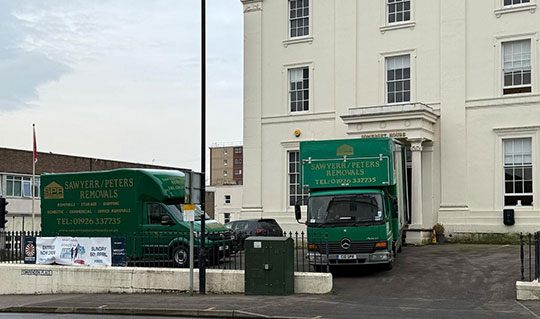WARWICKSHIRE`S REMOVAL AND STORAGE COMPANY
Offering full removals service and solutions we offer you everything from home, office, commercial removals to our specialist piano removals service, Sawyerr/Peters Removals have you covered. whether it is local, nationwide or overseas.
Contact Us,
- Unit 14, Southfield Road, Kineton Road Industrial Estate, Southam, Warwickshire, CV47 0FB
- 01926 33 77 35
- sawyerrpeters@aol.com
- Monday to Friday: 9am – 2pm
Safely Pack Your Belongings for a Move
- By spr-admin
- |
- 26 August 2025
Packing Hacks: How to Safely Pack Your Belongings for a Move
Moving to a new home or office is an exciting adventure, but the thought of packing everything you own into boxes can quickly become overwhelming. Whether you’re relocating across town or moving to another part of the country, the way you pack your belongings will play a big role in how smooth and stress-free your move is. Poor packing can result in broken items, wasted space, and unnecessary stress, but with the right tips and tricks, you can keep everything safe, organised, and ready to be unpacked at your new address.
Here’s a guide packed with clever hacks and practical advice to help you safely pack your belongings for a move.
Start With a Packing Plan
Before you reach for the boxes and tape, take some time to plan your approach. Create an inventory of your belongings, or at least prioritise the rooms you’ll tackle first. Bedrooms, kitchens, and living rooms are typically the most time-consuming, so starting there can save stress later.
Decide whether you want to pack gradually over a few weeks or do it all in one concentrated burst. Label a few essentials that you’ll keep unpacked until moving day, such as toiletries, chargers, and documents. Having a plan ensures you stay on track and don’t leave everything until the last minute.
Declutter Before You Pack
One of the biggest mistakes people make is packing everything they own without considering whether they actually need it. Moving is the perfect opportunity to declutter. Sort through each room and separate items into three categories: keep, donate, and discard.
Not only does decluttering reduce the amount you need to move, but it also saves on packing materials, time, and moving costs. Charities often welcome gently used clothing and household items, while recycling centres can take care of broken or unwanted goods.
Invest in Quality Packing Supplies
Using the right supplies can make all the difference in protecting your belongings. While it may be tempting to use old boxes or supermarket freebies, these are often flimsy and may not hold up during a move. Instead, invest in:
Sturdy cardboard boxes in various sizes
Heavy-duty packing tape
Bubble wrap and packing paper
Stretch wrap for furniture
Mattress and sofa covers
Permanent markers for labelling
Reusable plastic bins are another excellent option, particularly if you anticipate storing items long-term. High-quality materials help keep fragile items secure and prevent damage in transit.
Label Everything Clearly
Labelling might sound obvious, but it’s one of the most overlooked parts of the packing process. Write the room name and contents on each box in large, clear letters. Colour-coded labels or tape can make things even easier: blue for kitchen, red for bedroom, green for living room, and so on.
Include “fragile” or “this side up” notes where appropriate. Not only does this help movers handle your items correctly, but it also makes unpacking at the other end much faster and less stressful.
Protect Fragile Items
Fragile items like glassware, crockery, and ornaments need extra care. Here are a few hacks to protect them:
Wrap glasses and mugs in socks for double cushioning.
Use clothing, towels, or bedding as padding instead of buying endless rolls of bubble wrap.
Place plates vertically in boxes like records to reduce the chance of breakage.
Fill empty spaces with crumpled paper or soft materials to stop items shifting.
Remember, the key is to prevent movement. A tightly packed box is far safer than one with gaps inside.
Use Suitcases and Bags Wisely
Why waste space in your moving van when you already own sturdy luggage? Suitcases are perfect for transporting heavy items like books, because their wheels make them easy to move. Duffel bags, laundry baskets, and gym bags are also great for packing soft items like clothing and linens.
This not only saves you from buying extra boxes but also makes unpacking easier, since you’ll already know where your essentials are.
Disassemble Large Furniture
Large furniture items such as beds, tables, and wardrobes can be awkward to move. Whenever possible, disassemble them before moving day. Keep screws, bolts, and fittings together in clearly labelled bags and tape them securely to the furniture piece they belong to.
Wrap furniture parts in blankets or stretch wrap to avoid scratches. Taking furniture apart not only prevents damage but also makes it easier to fit everything through doors and into the moving van.
Pack an Essentials Box
The last thing you want after a long day of moving is to rummage through dozens of boxes looking for a toothbrush or kettle. Prepare an essentials box with everything you’ll need for the first 24–48 hours in your new home.
Include items like:
Toiletries and medication
A change of clothes
Phone chargers and electronics
Snacks and drinks
Important documents
Basic cleaning supplies
Having this box on hand will make your first night in your new home much more comfortable.
Keep Clothes on Hangers
A simple hack for clothing is to leave items on their hangers. Slide a bin bag over a group of clothes, tie it at the bottom, and you’ve created an instant garment bag. This keeps clothes clean, organised, and ready to hang straight up in your new wardrobe. Wardrobe boxes are another option if you want a more professional approach.
Don’t Overpack Boxes
It can be tempting to cram as much as possible into each box, but this often leads to ripped boxes, injuries, or damaged items. Follow this rule of thumb: heavy items like books go in small boxes, while lighter items like linens or cushions can go in larger ones.
A well-packed box should be easy to lift without straining. Distribute weight evenly and make sure boxes can close securely without bulging.
Special Care for Electronics
Electronics like TVs, computers, and gaming consoles need careful packing. If possible, use their original boxes with fitted foam inserts. If that’s not available, wrap each item in bubble wrap, then place it in a sturdy box filled with padding.
Take photos of cable setups before unplugging everything—this makes reassembly much easier at your new place. Store cables in labelled bags and tape them to the device they belong to.
Bonus Hacks for Smooth Packing
Use cling film to keep toiletries and liquids from leaking.
Wrap drawers with stretch wrap instead of emptying them.
Tape cords to appliances so they don’t tangle.
Use egg cartons for small fragile items like jewellery or lightbulbs.
Pack room by room to stay organised.
Conclusion
Packing for a move doesn’t have to be stressful. With the right hacks, supplies, and preparation, you can protect your belongings, stay organised, and make moving day far smoother. Decluttering before you start, investing in quality materials, and using clever shortcuts like socks for glassware or bin bags for clothes on hangers can save you both time and money.
Remember: pack smart, not hard. By following these packing hacks, you’ll not only safeguard your possessions but also enjoy a more relaxed start in your new home. Moving may be a big job, but with a strategic approach, it’s a challenge you can handle with ease.
Dear Mr Peters Just a few lines to say thank you for all your help moving my furniture to Nice in the South of France. A very polite and professional team collected and more importantly delivered and unloaded in Nice on time and with no damage. I have no hesitation in recommending your company. Thanks again to all your team. Mr C Davies
Recent News

Safely Pack Your Belongings for a Move

Professional Removal Company or DIY
